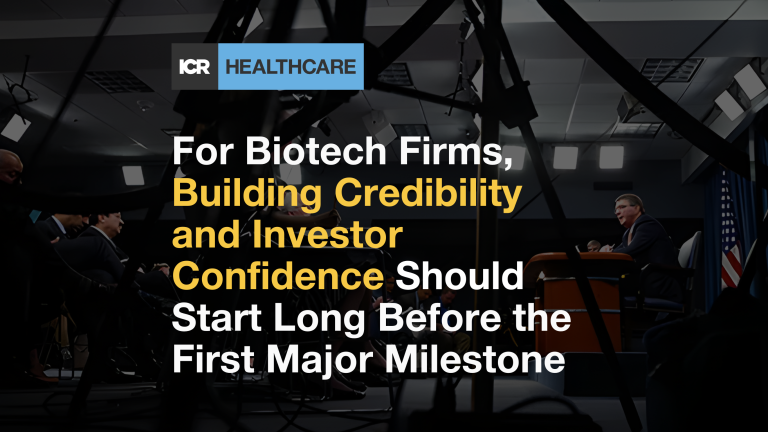Attending Wall Street investment banking conferences is a large part of a strategic investor relations plan. Along with non-deal road shows, management’s visibility and interaction with buy-side accounts during one-on-one meetings are critical for conveying your story to potential investors, addressing unanswered questions, and expanding on an investment theme. But, finding the appropriate conference strategy can be harder than it seems, especially when it comes to lining up a successful meeting schedule with key buy-side accounts.
For private companies well ahead of an IPO, developing relationships to garner conference invitations can sometimes be challenging. Then getting the attention of potential investors at those meetings takes some perseverance and creativity. That can also be the case for smaller cap, more illiquid names with an absence of upcoming news to report. On the opposite end of the spectrum are larger cap companies that may not be able to make enough meeting time to accommodate all the requests.
CEOs and CFOs often ask us, “What is the best way to make a banking conference most efficient?” Management teams are often flying across the country, or even across the ocean, to attend a conference. No one wants to show up to see the same people they just met with the week before or walk away thinking they had meetings with portfolio managers who can’t possibly own their stock. For these reasons, we always think the goal of a conference should be the quality of the meetings versus the quantity of meetings.
Below are a few ways to get the most out of your investment banking conference attendance:
Have a plan for how many conferences and which ones. While the total number of investor conferences your company presents at in a year depends on management’s availability, we generally suggest a goal of six to eight annually. Too few does not create adequate visibility and attending too many can make investors wonder if you are spending too much time selling stock than running the business. Think about the reason for attending a specific conference: Is it to build a relationship with a banker, educate a new analyst, or seek out a new set of investors?
Mix up the types of conferences you attend, beyond geographical diversity. Have a mix of healthcare-focused, small cap, sector specific, as well as growth-stock oriented conferences baked into your IR plan. Each brings a different audience, which is beneficial for a well-balanced investor base. Additional conferences, including non-brokerage conferences (e.g., BIO) can also be added as schedules permit.
Be open to participating in conferences of different sizes and styles – smaller ones can offer benefits too.
More and more banks are favoring one-on-one meetings instead of formal presentations. Although on the surface these meetings do not appear to attract the same large attendance, we have found them very valuable if you can get a good schedule with eight or nine back-to-back meetings.
We also think middle-market firms arrange some of the best investor conferences for biotechnology companies and typically attract healthcare focused accounts. If the conference has panel discussions, consider asking to be put on one. Although not a replacement for one-on-ones, panels can be great exposure for senior management especially of a younger company trying to establish credibility.
Be proactive with your schedule. Develop your own target list of accounts to see. Working with the conference coordinators and the corporate access team to arrange an optimal meeting schedule takes time and several iterations. We find that developing a short list of “must see” accounts ahead of time and then providing that list to the coordinators, and your IR partner, is an effective way to achieve a solid schedule. While everyone on your list may not be attending, the conference people are usually very helpful in trying to meet your requests when possible. If there are specific accounts you have been trying to see, be opportunistic and see if they are attending a particular conference. If you find they will be there, suggest they put in for a one-on-one meeting with you. Also, remember to check your schedule often as the conference approaches given that schedules change frequently.
Pair group meetings appropriately. For situations, where there are not enough meeting slots to go around and one-on-ones become two-on-ones, three-on-ones (or even larger), know who will be together in the room. In certain cases, meeting times are arranged based on availability as opposed to investment style. It can be a difficult meeting if you have someone who is well versed on your company and is a large shareholder sitting next to someone who is the biggest fan of your closest competitor and is short your stock. Try to know the background of your investors. Do they own the stock? Did they just sell their position? Are they completely new to the story? We like to have similar investors in group meetings so that the discussion does not get swayed by one person who has a hidden agenda. Don’t be shy about asking to realign the groupings of the meetings to optimize your discussions.
Although time consuming, investment banking conferences (especially one-on-one meetings) are an excellent way to communicate with investors. At the end of the day, after attending a banking conference, there should be a sense that you introduced your company to some new investors while also presenting a fresh update to several of your current ones.
Need assistance with how to better utilize banking conferences for your company? Westwicke can help maximize your next conference schedule. Get in touch.



